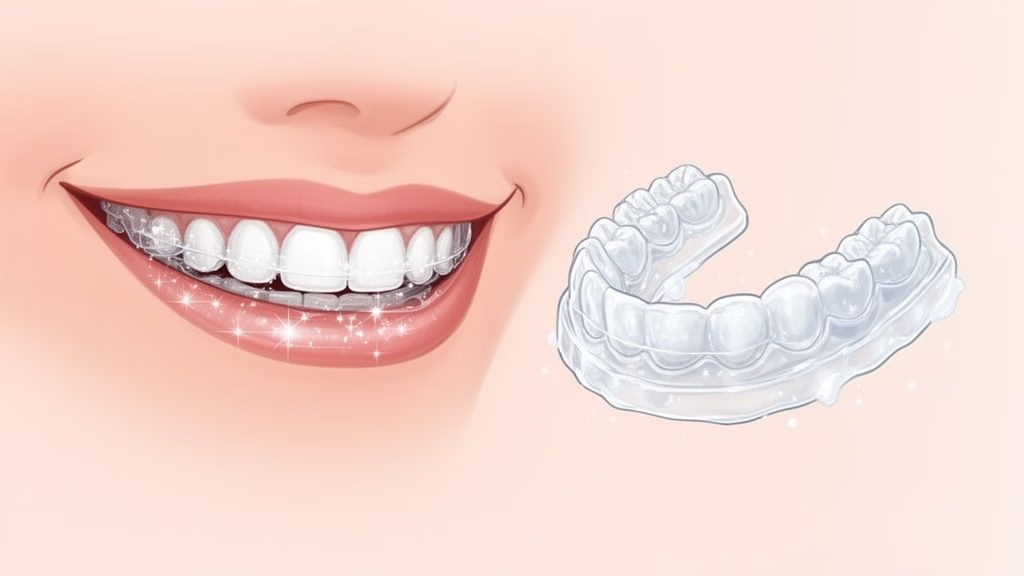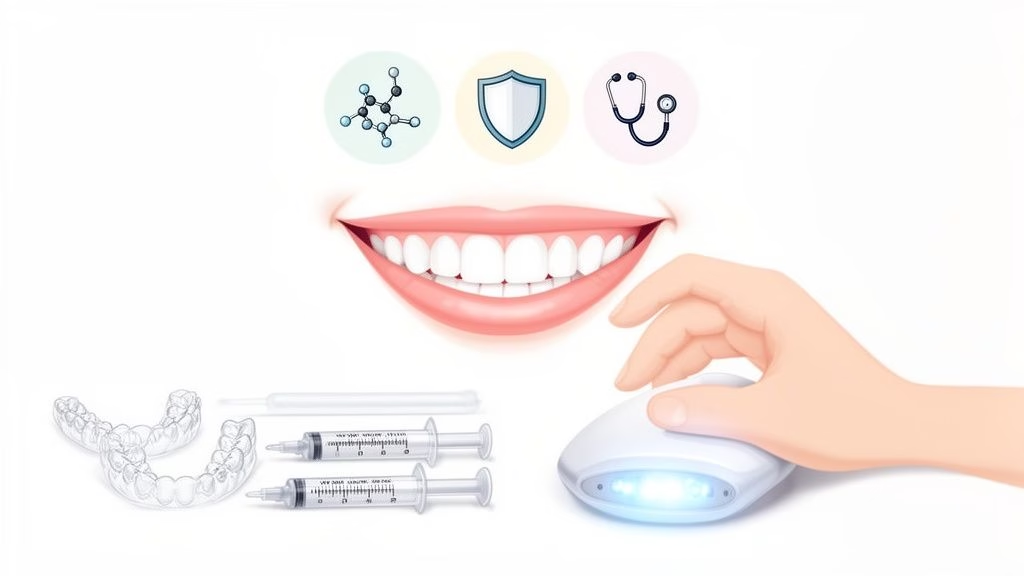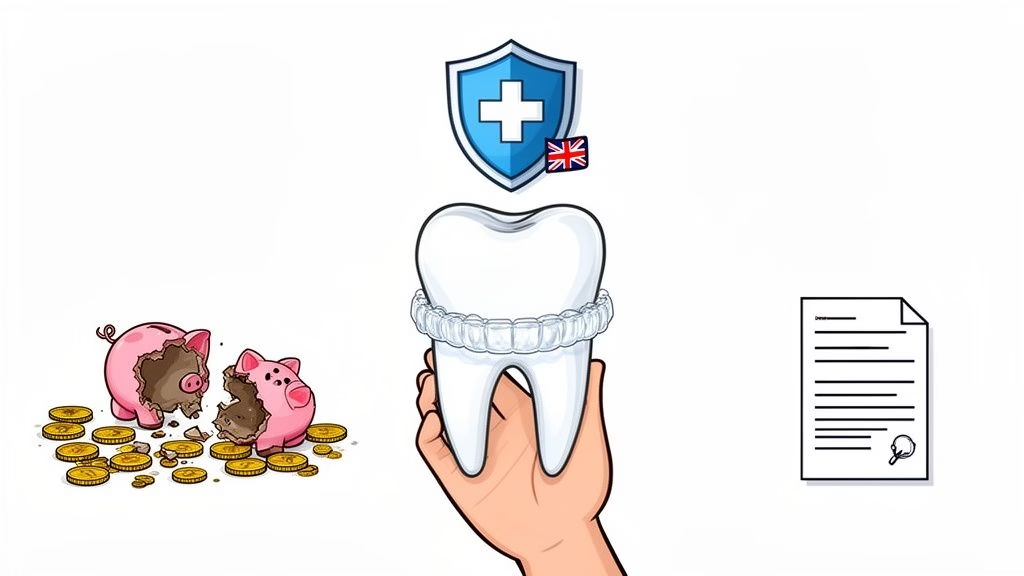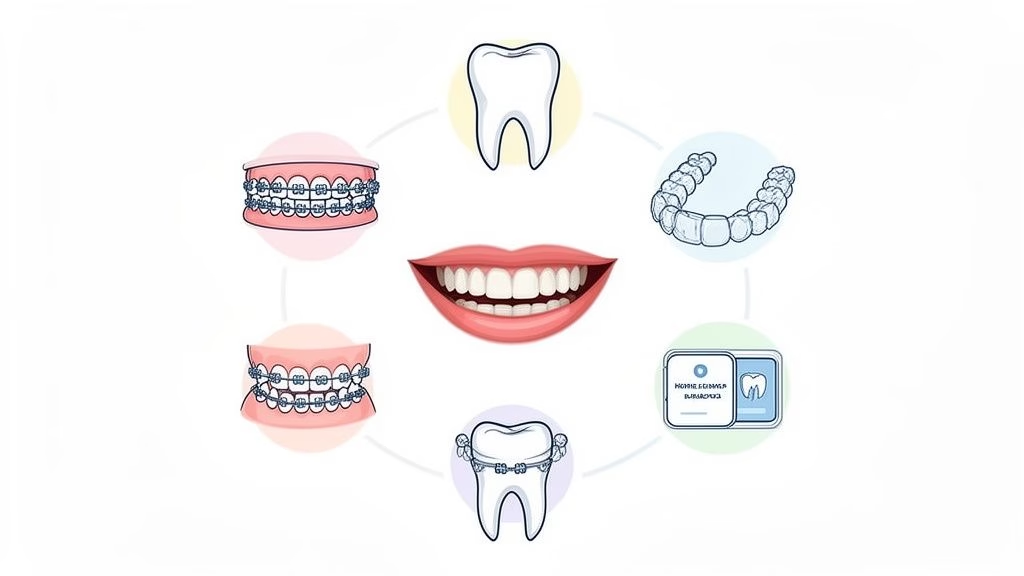Digital Transformation in Healthcare Explained
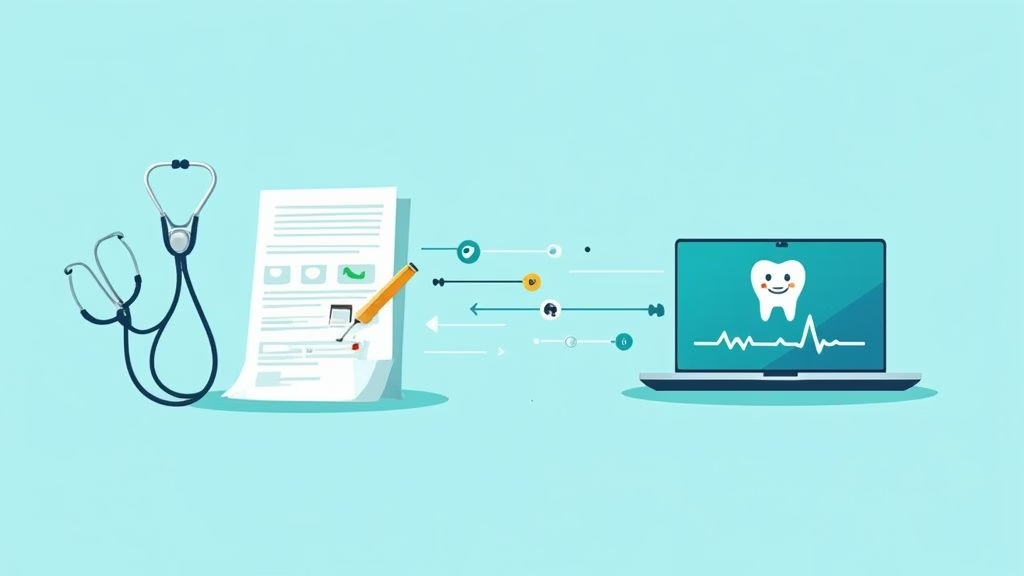
Think back to the last time you visited a bank branch. For most of us, it’s a distant memory. We now manage our finances instantly from our phones—checking balances, transferring money, and paying bills in seconds. That same leap from queues and paperwork to on-demand, digital-first service is exactly what’s happening in healthcare.
Understanding Digital Transformation in Healthcare
Digital transformation in healthcare isn’t about simply bolting new technology onto old systems. It’s a complete overhaul of how we think about and deliver care, fundamentally rebuilding the ecosystem from the ground up.
It’s about moving away from fragmented, paper-based processes and towards a connected, intelligent system that puts patients first. To get a real sense of this shift, it’s worth exploring the Digital Transformation in Healthcare: Key Strategies for Success that pioneering organisations are adopting. At its core, this movement is all about creating a seamless journey for both patients and clinicians.
The Core Pillars of This Change
This isn’t just one big idea; it’s a change built on several key pillars, each designed to tackle a long-standing frustration with traditional healthcare.
- Empowering Patients: Imagine having direct access to your own health records, being able to book appointments without a phone call, and messaging your care team directly. This pillar puts you firmly in the driver’s seat of your health journey.
- Boosting Operational Efficiency: By automating routine admin tasks and streamlining clinical workflows, we can cut down on the mountain of paperwork. This frees up doctors, dentists, and nurses to do what they do best: care for patients.
- Enabling Data-Driven Decisions: When we can analyse health data effectively, we can spot trends, predict disease outbreaks, and tailor treatment plans to individuals for far better results.
- Creating Integrated Care Journeys: This ensures your GP, specialist, dentist, and hospital all have the same, up-to-date information, giving them a complete picture of your health and avoiding repeated tests or lost records.
This is more than just a tech upgrade. It’s a profound cultural shift that places the patient at the very centre of a smarter, more connected, and truly accessible healthcare model, influencing everything from the NHS down to how you manage your personal well-being.
Take dentistry, for instance. Digital transformation is making specialist care far more accessible. Instead of endless trips to a clinic for consultations and adjustments, companies like Toothfairy are using technology for remote monitoring and direct-to-consumer services.
This approach strips out the inefficiency from cosmetic treatments like teeth straightening, offering a smarter and more affordable alternative to specific aligner brands that still rely on frequent—and costly—in-person appointments. It’s a perfect, real-world example of digital transformation delivering clear, tangible benefits directly to the patient.
The Forces Driving Healthcare’s Digital Revolution
The move towards digital healthcare isn’t happening in a vacuum. It’s being pushed forward by several powerful, interconnected forces. Just think about how you book a holiday or order a takeaway today. Would you use a landline and a paper directory? Of course not. Modern consumers expect that same seamless, on-demand service from their healthcare providers.
This fundamental shift in patient expectations is arguably the biggest driver. People are no longer happy to be passive recipients of care. They want to be active participants, demanding convenience, transparency, and real control over their own health journey. The days of waiting weeks for an appointment and dealing with cumbersome paper records are numbered.
The Pressure for Greater Efficiency
Alongside what patients want, health systems like the NHS are facing enormous operational pressure. Budgets are tight, but the demand for services is constantly on the rise, thanks to an ageing population and more complex health conditions. This creates an urgent, almost desperate, need to do more with less.
Digital tools offer a direct answer to this problem. By automating routine admin, streamlining workflows, and allowing for smarter data analysis, technology helps healthcare providers work more efficiently. This isn’t just about saving money, either. It’s about freeing up clinicians’ precious time to focus on what actually matters: patient care, not paperwork.
We see this push for efficiency in dentistry, too. Models like Toothfairy’s are built on a digital-first foundation, using technology to cut out the fat. By offering virtual consultations and remote monitoring for teeth straightening, we deliver a process that is far more affordable and accessible than specific aligner brands that still rely on multiple, costly in-person visits.
The Accelerating Role of Global Events and Policy
Recent global health crises threw petrol on the fire, forcing healthcare to adopt digital tools out of sheer necessity. Telehealth, once a fringe service, went mainstream practically overnight. It proved to everyone that remote care could be both effective and incredibly convenient.
That momentum is now being locked in by government policy. In England, for instance, the NHS is actively pursuing a digital-first agenda. A huge part of this is the NHS 10-Year Plan, which was shaped by insights from over 250,000 members of the public. It focuses on moving care out of hospitals and into community settings, all connected by integrated digital platforms. The aim is to give local services the tools for seamless data sharing—a cornerstone of a truly connected health system. You can read more about the NHS’s landmark digital strategy to get the full picture.
These forces—patient demand, systemic pressure, and strategic policy—aren’t acting alone. They’re converging to create a perfect storm, making the digital shift in healthcare an urgent necessity, not a far-off dream.
Ultimately, these drivers are completely redrawing the map of the patient-provider relationship. They’re paving the way for a more proactive, personalised, and sustainable way of delivering healthcare, where technology empowers both sides to achieve better results. The revolution is already here, fuelled by the undeniable need for a smarter, more responsive system.
The Tech Powering Modern Healthcare
To really get to grips with digital transformation in healthcare, we need to pop the bonnet and look at the engine. We’re talking about the specific technologies that make it all happen. These aren’t just abstract ideas; they’re real, practical tools that are changing the day-to-day reality for clinicians and patients alike. From forecasting health trends to having a consultation in your living room, these technologies are the building blocks of a smarter, more connected healthcare system.
The image below shows this shift beautifully. It paints a picture of a more collaborative relationship between doctors and patients, where technology smooths out the entire journey of care.

What you’re seeing is a move towards a model where the patient is truly at the centre, with both parties empowered by easy access to data and clear lines of communication.
To see how this works in practice, let’s break down the key technologies one by one.
Core Technologies in Healthcare’s Digital Shift
This table breaks down the essential tools, explaining what they do and how they’re being used on the ground right now.
| Technology | Primary Function in Healthcare | Application Example |
|---|---|---|
| Artificial Intelligence (AI) & Machine Learning | Analysing complex medical data to find patterns, predict outcomes, and automate tasks. | An AI algorithm scans a dental X-ray, highlighting potential cavities and areas of bone loss for the dentist’s review. |
| Telehealth & Remote Monitoring | Delivering clinical care and monitoring patient health from a distance using digital communication tools. | A patient has a video consultation for teeth straightening and uses a smartphone app to send progress photos to their dentist. |
| Electronic Health Records (EHRs) | Creating a single, secure digital record of a patient’s entire health history. | A GP instantly accesses a patient’s hospital discharge summary, ensuring seamless continuity of care. |
| Big Data & Analytics | Examining vast, anonymised health datasets to identify public health trends and improve treatment effectiveness. | Public health officials analyse regional data to predict a flu outbreak and allocate resources accordingly. |
Each of these technologies plays a vital role, but their real power is unlocked when they work together.
Artificial Intelligence and Machine Learning
Think of Artificial Intelligence (AI) as a super-smart assistant for healthcare professionals. It can sift through enormous amounts of data—like medical images or patient histories—and spot subtle patterns that the human eye might miss. The result? Faster, more accurate diagnoses and treatment plans tailored to the individual.
A great example is in dentistry. An AI algorithm can scan a dental X-ray and flag potential trouble spots like tiny cavities or early signs of bone loss with incredible precision. It doesn’t replace the dentist, but it sharpens their focus and makes their expertise even more powerful.
Within this field, advanced medical speech recognition technologies are making a huge difference to clinical workflows. These AI-powered tools can instantly turn a doctor’s spoken notes into a typed record, slashing admin time and reducing the risk of mistakes from manual data entry.
Telehealth and Remote Patient Monitoring
Telehealth is simply the digital bridge that connects patients and clinicians, no matter where they are. Through video calls, secure messaging, and online portals, it makes consultations and follow-up care possible from a distance. This has been a complete game-changer for accessibility, especially for people with mobility challenges or those living in remote areas.
This technology is at the heart of modern, affordable dental care. Companies like Toothfairy use it for initial consultations and to monitor progress for treatments like teeth straightening. This digital-first approach cuts out needless trips to the clinic, which is a big reason why it’s a smarter, more affordable choice compared to aligner brands that build the high cost of frequent, in-person appointments into their price.
A close cousin to telehealth is remote patient monitoring. This is where wearable devices (part of the Internet of Things, or IoT) track vital signs like heart rate or blood sugar in real time, alerting care teams to potential issues before they escalate.
Electronic Health Records and Big Data
Imagine a single, secure digital file containing a patient’s entire medical history. That’s an Electronic Health Record (EHR). Instead of paper files scattered across different clinics, an EHR gives authorised clinicians a complete, unified view of a patient’s health in an instant. This stops duplicate tests and ensures every professional has the full picture.
When you gather and anonymise the data from millions of these EHRs, you get Big Data. Crunching this information gives public health officials incredible insights, allowing them to:
- Predict disease outbreaks by tracking symptom patterns across a population.
- Identify at-risk communities that might need targeted health campaigns.
- Measure how well treatments work by seeing which therapies are most effective on a massive scale.
It’s crucial to remember that these technologies aren’t islands. Their real magic happens when they connect and work together. AI needs the rich data from EHRs to learn, and telehealth is made safer and more effective with remote monitoring. Together, they form the technical backbone of a healthcare system that is more proactive, personalised, and focused on the patient than ever before. This synergy is the very heart of digital transformation.
The Real-World Benefits for Patients and Providers
This digital shift is far more than just a buzzword; it delivers real, tangible advantages that genuinely improve the experience for everyone involved. For patients, it’s about finally getting the control and convenience they’ve come to expect in every other part of their lives. For clinicians, it means smarter ways of working and more time to focus on what actually matters: looking after people.
We’re not just tweaking old processes here. We’re creating entirely new, more effective ways to deliver care. The positive effects ripple outwards, touching individuals, providers, and the entire healthcare system.
A New Era of Patient Empowerment and Access
Perhaps the most profound change digital transformation brings is how it empowers patients. The days of being a passive recipient of care are over. Technology now puts people right at the centre of their own health journey.
Think about it: online portals and simple apps have torn down the old walls. Patients can book appointments with a few taps on their phone, order repeat prescriptions without sitting on hold, and securely view their own medical records. This isn’t just convenient; it fosters a real sense of ownership and a deeper understanding of one’s health.
In dentistry, this translates to much easier access to specialist advice. A great example is Toothfairy, which uses teledentistry to offer virtual consultations for all sorts of issues, from dental emergencies to cosmetic work. Their model makes treatments like teeth straightening much more accessible and affordable than some aligner brands that lock you into multiple, costly in-person visits. The savings from digital efficiency are passed straight on to the patient.
By placing powerful tools directly into patients’ hands, digital transformation fosters a proactive, rather than reactive, approach to health and wellness. This shift is not just about convenience; it’s about creating more engaged, informed, and empowered patients.
Streamlining Workflows for Healthcare Professionals
Ask any doctor, dentist, or nurse, and they’ll tell you the mountain of administrative work can be overwhelming. It eats into the time they could be spending with patients. Digital tools are the perfect antidote, automating routine tasks and making clinical workflows much smoother.
Electronic health records, for instance, mean no more hunting for paper files; a patient’s entire history is available instantly. Digital prescribing cuts down on errors and saves a huge amount of time. To really grasp the impact, it helps to understand the practical advantages like improved data accuracy—you can see how specific tools are making a difference by exploring these Medical Voice Charting Benefits.
When you free up clinicians from tedious paperwork, they can dedicate their expertise and energy to what they were trained for: complex diagnoses, thoughtful treatment planning, and building a proper rapport with patients. It’s about augmenting their skills, not replacing them.
System-Wide Gains in Efficiency and Outcomes
On a grander scale, the benefits stretch across the entire healthcare system, leading to massive cost savings and better health for the population as a whole. The NHS offers a fantastic real-world example of this in action.
The NHS App, a cornerstone of its digital-first strategy, has been a huge success. Over 25% of the UK population aged 13 and over now logs in every month. This incredible adoption has saved GP practices an estimated 2.6 million hours through online appointment booking and prescription services alone. What’s more, the move to digital messaging has meant 11 million fewer letters are sent out each year.
The financial impact is just as impressive. By early 2025, these digital services had delivered £265 million in benefits, smashing initial forecasts. By using data analytics, health systems can also start to predict public health trends, manage resources more effectively, and build a more resilient service for everyone.
How Digital Innovation is Reshaping Dentistry
The idea of a digital revolution in healthcare isn’t some abstract concept for the future; it’s unfolding right now in your local dental practice. In fact, dentistry is one of the clearest examples of this shift, moving away from old-school, often clunky methods towards a smarter, patient-first approach. It’s a fantastic real-world look at how technology can make specialised care better, easier to access, and lighter on the wallet.
Take teledentistry, for instance. It has completely flipped the script on how patients and dentists interact. You can now get professional advice for a chipped tooth, have a quick follow-up chat after a procedure, or even get the ball rolling on a cosmetic treatment, all from your living room. This kind of remote access tears down some of the biggest hurdles that stop people from getting the care they need.
From Impressions to Pixels: The 3D Revolution
The changes inside the clinic are just as striking. Remember those uncomfortable trays of gooey impression material? For many procedures, they’re a thing of the past. Now, intraoral scanners can create incredibly precise 3D digital models of your mouth in just a few minutes. This isn’t just about making you more comfortable; it’s about getting things right the first time.
These detailed digital blueprints are the starting point for a whole new generation of dental work. They’re used to design and craft everything from crowns and bridges to custom-fit clear aligners with an amazing level of accuracy. The result is better-fitting dental work and more predictable results, which means fewer trips back to the dentist for adjustments.
By digitising the very first step of many dental procedures, the entire workflow becomes faster and more reliable. This digital accuracy is the cornerstone of modern, efficient dental care, setting the stage for more advanced applications.
And when you pair this with on-site 3D printing, the possibilities expand even further. Clinics can now produce things like surgical guides or temporary crowns on the same day. This cuts out the long delays waiting for an external lab to do the work and puts the dentist firmly in control of quality. For the patient, it all adds up to a faster, more responsive experience.
Making Teeth Straightening Smarter and More Affordable
This digital-first mindset is completely changing cosmetic dentistry, especially when it comes to clear aligners. This is exactly where forward-thinking companies like Toothfairy are making a real difference by fully embracing a modern, tech-driven model. By using teledentistry for initial consultations and remote progress checks, we cut out many of the unnecessary and expensive steps in the journey.
This is a world away from the traditional approach of some aligner brands, which often involve a long series of pricey in-person appointments that just add to the final bill. Those old methods have inefficiency and high costs built right into their structure.
The Toothfairy model shows how digital innovation can bring real, tangible benefits:
- Reduced Overheads: Fewer required visits to a physical clinic mean lower running costs for us.
- Passed-on Savings: These efficiencies mean we can offer teeth straightening and other cosmetic treatments at a much more accessible price.
- Greater Convenience: You save time and money on travel, allowing treatment to fit neatly into your life, not the other way around.
This isn’t just about being a cheaper option; it’s about being a smarter one. By using technology intelligently, we make getting that confident smile a realistic goal for more people. This whole approach—using digital tools to simplify processes, cut costs, and boost convenience—is what digital transformation in healthcare is all about. It proves that when we rethink how care is delivered, everyone comes out ahead.
What’s Holding Digital Healthcare Back?
The idea of a fully connected, digital healthcare system is genuinely exciting, but let’s be honest—the road to get there is full of potholes. Simply switching on new technology isn’t enough. We have to steer carefully around some serious obstacles, because getting it wrong means wasted money, failed projects, and, most importantly, potential risks to patients.
One of the biggest worries, and rightly so, is data privacy and cybersecurity. We’re talking about some of the most sensitive information imaginable. The more we move this data online, the more it becomes a tempting target for hackers. Protecting it isn’t just a technical task; it’s fundamental to keeping patient trust and staying on the right side of the law.
Tackling the Tech and the Till
Beyond security, there’s a huge technical headache called interoperability. It’s a fancy word for a simple problem: getting different digital systems to talk to each other. Think about it. Your GP’s system needs to share information smoothly with the local hospital, and both should be able to connect with a specialist dental platform. If they can’t, we just end up with digital silos, which defeats the whole purpose of a joined-up system.
Then there’s the money. Rolling out new technology, from software licenses to the hardware it runs on, costs a fortune. For health services already operating on tight budgets, this financial strain is a very real barrier.
Getting these things right isn’t just about making the tech work; it’s an ethical responsibility. A truly successful digital shift has to be secure, connected, and accessible to everyone. The aim is to use technology to close gaps in care, not create new ones.
The sheer scale of this investment is staggering. In 2025, the UK’s digital health market was valued at about USD 15.46 billion, and it’s projected to rocket to USD 36.84 billion by 2030. The government is injecting serious cash to fuel this, with specific digital funds going directly to England’s Integrated Care Systems to make change happen on the ground. You can dive deeper into the UK’s digital health market growth on mordorintelligence.com.
It’s All About People, Really
At the end of the day, technology is just a tool. It’s the people using it that make it work. Two major human challenges always come to the forefront:
- Getting Staff On Board: You can install the most brilliant piece of software, but if the staff aren’t trained or confident enough to use it, it’s useless. Getting buy-in from the doctors, dentists, and nurses on the front line is absolutely critical for any of this to stick.
- Making Sure No One Is Left Behind: We also have a duty to make sure these digital advances don’t exclude people. Not everyone is a tech whiz, so systems need to be designed for everyone, with support for those who struggle. The goal is better access for all, not just for the digitally savvy.
Got Questions About Digital Healthcare? We’ve Got Answers
Stepping into this new world of digital care can feel a bit strange. It’s exciting, for sure, but it also changes how we approach something as personal as our health. It’s only natural to have a few questions, so let’s tackle some of the most common ones.
Is My Personal Data Really Secure?
Yes, it is. In fact, protecting your sensitive health information is the number one priority. Think of it this way: a locked filing cabinet in an office is vulnerable, but a digital file is a different beast entirely.
Systems used by the NHS and trusted digital health providers use powerful encryption and follow strict security rules, like GDPR. This makes digital records significantly more secure than their paper predecessors, with a clear digital footprint that shows exactly who has accessed your information and when.
Is a Robot Going to Replace My Doctor or Dentist?
Not a chance. The goal here is to give healthcare professionals better tools, not to replace them. These digital systems are designed to take over the tedious admin, offer up more precise data for diagnostics, and handle simple communications.
This frees up your doctor or dentist to focus on what they do best – the human stuff. Things like untangling complex health problems, building a trusting relationship with you, and making those crucial treatment decisions. Technology supports their expertise; it doesn’t try to automate it.
Digital healthcare isn’t about technology versus people. It’s a partnership. The tech handles the repetitive work so your clinical team can give you their full, undivided attention.
How Does This Actually Make Dental Care Cheaper?
It all comes down to efficiency. Digital technology cuts out a lot of the steps that traditionally added time and cost to your treatment. For instance, teledentistry means you don’t always have to travel to a clinic for a simple check-in or an initial chat.
Digital imaging and 3D printing have also slashed the manufacturing costs for things like custom-made clear aligners. It’s these efficiencies that forward-thinking companies are built on.
- Virtual Consultations: Fewer in-person appointments for simple assessments means less overhead and lower costs.
- Smarter Production: Digital workflows make creating custom dental appliances much more cost-effective.
- Direct-to-You Models: By cutting out the middlemen, those savings get passed straight on to you.
This is precisely the model we use at Toothfairy to make treatments like teeth straightening more accessible. Our digital-first approach means we can offer expert care at a much friendlier price point than the old-school, clinic-heavy models some aligner brands still rely on.
Ready to see how a digital-first approach can make your dream smile a reality? With Toothfairy, you get dentist-prescribed cosmetic and emergency dental care that’s smarter, more convenient, and more affordable. Discover your options today at https://www.toothfairyapp.co.uk.
Last updated on September 8, 2025

Toothfairy Care Team
Toothfairy, is the world's smartest dental app, that connects patients to a dentist for a range of issues, from emergencies, cosmetics, prescriptions to virtual exams.
Toothfairy Care Team
Toothfairy, is the world's smartest dental app, that connects patients to a dentist for a range of issues, from emergencies, cosmetics, prescriptions to virtual exams.
